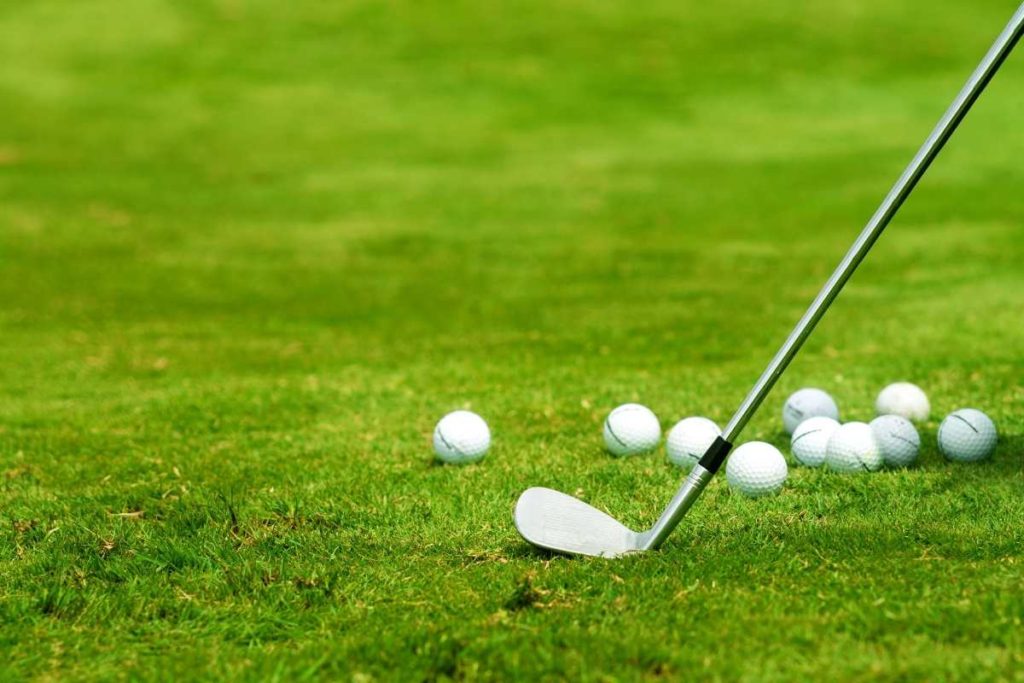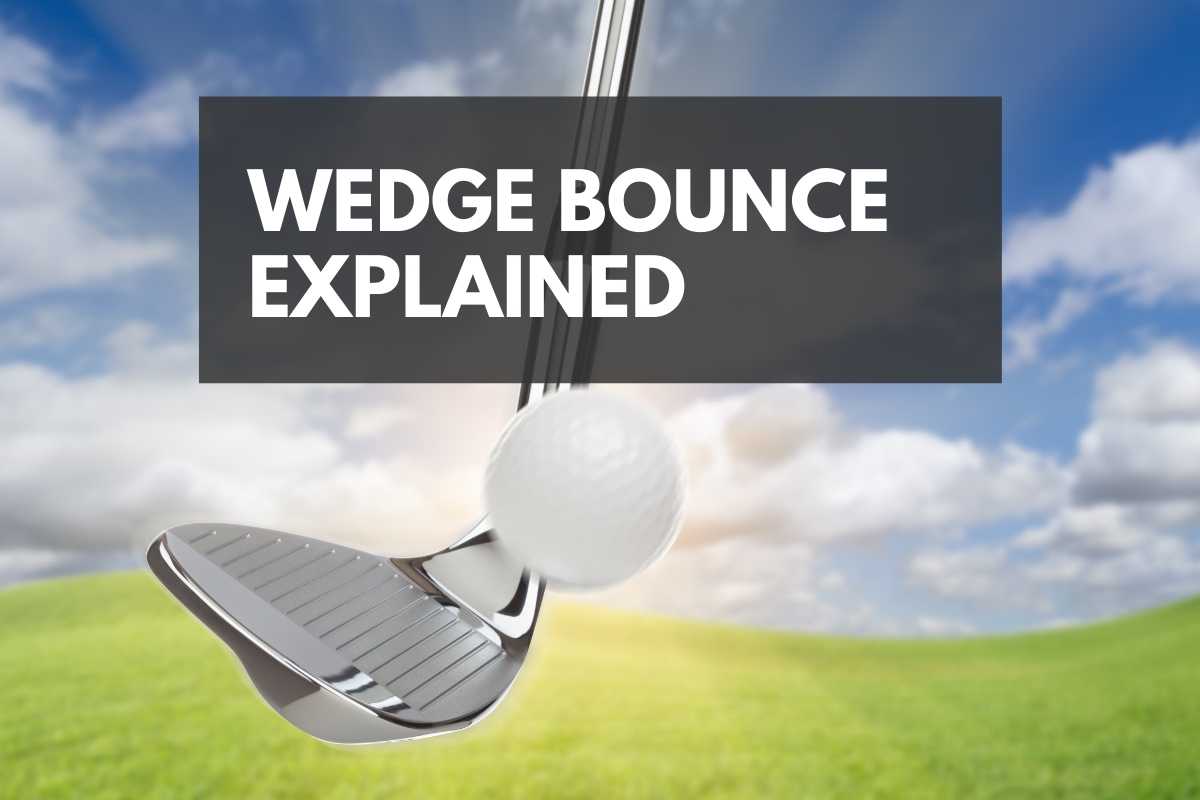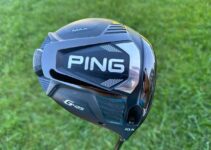Having the correct wedge bounce on your wedges can help you shave strokes off your game. The optimal wedge bounce for your swing and course conditions gives you more forgiveness.
We all know how hard golf can be. So, it’s always nice to get some added forgiveness, especially when it means we can hit closer approach shots.
Your short game (from within 100 yards) is where you will hit most of your golf shots. If you want to lower your handicap, it’s vital to understand which wedge bounce is right for a specific club and learn how to use it.
Chunked wedge shots are a common problem for many golfers. But having the correct bounce on your wedges can help prevent you from chunking the ball. That might save you a few shots per round.
What is Wedge Bounce?
Wedge bounce is the angle created between the leading edge of the clubhead and the lowest point of the sole (or trailing edge) when the clubhead rests on the ground at address.
The trailing edge of the club hits through the ground as it contacts the ball. So, more bounce gives you more forgiveness.
The higher the wedge bounce degree is, the higher your leading edge will be off the ground when you line up for your shot. A higher leading edge gives you more forgiveness because it makes it easier for you to get proper contact on the ball.
So, even if you make a mistake with the swing, a higher wedge bounce can bail you out of trouble. You can still make good contact and make the green.
The proper wedge bounce for your swing gives you more control over your short game. Getting the best contact on the ball helps your accuracy and promotes optimal ball spin. Those are the ingredients for hitting closer approach shots with your wedges.

Different Types of Bounce
The three different types of bounce are low, mid, and high. Each bounce has a different degree range and suits various players and course conditions.
Low Bounce (4-6 Degrees)
Low wedge bounce is considered between four and six degrees. It means the leading edge of the club sits low off the ground.
Wedges with a low bounce are harder to use effectively. Only better players should generally use low-bounce wedges for that reason.
Higher handicappers tend to hit a lot of chunk shots with these wedges. That’s because the leading edge can dig into the turf instead of bouncing up to make good contact with the ball.
For that reason, low-bounce wedges work better on firm turf. The low leading edge won’t dig into the firm ground as much, so you can get good contact with the ball.
Also, low-bounce wedges are better for bunkers with harder or coarse sand. Again, the leading edge won’t dig as much, meaning you don’t need the higher bounce in these conditions.
A lower bounce also gives players more versatility on shots. Tour players prefer them because they allow golfers to hit a variety of shots around the greens. They’re particularly effective when players need to open the face for high lob shots, which offers a little more forgiveness.
However, you have little room for error when you hit wedge shots with a square face. You get rewarded when you strike a low-bounce wedge cleanly because it offers excellent control and spin.
Low-bounce wedges are also great for shots from tight lies. The lower leading edge makes it easier to nip the ball off the turf.
Golfers with shallow swings are better suited to low-bounce wedges. They have a shallow angle of attack and sweep the ball off the turf without taking deep divots. So, there’s not much chance of their leading edge digging into the ground.
Mid Bounce (7-10 Degrees)
A mid-bounce wedge has between seven and 10 degrees. These clubs are also known as medium or standard-bounce wedges. They’re more versatile than low-bounce wedges, and golfers can use them in firm or normal turf conditions.
The average golfer who plays different courses throughout the year will likely rely more on these types of wedges because they won’t know the course layout, what the turf feels like, or how the sand is in the bunkers. Mid-bounce wedges tend to cover all bases, so you can rely on them in various conditions.
This type of bounce can be used around the green for many different kinds of shots and offers plenty for any golfer who likes to play their wedge shots with a square face or an open face. Opening the clubface for lob shots will add more bounce but not too much.
Mid-bounce wedges fit a wide variety of golfers because of their versatility. However, players with a neutral swing and moderate attack angle will get the most from them. You can control the trajectory better, as this wedge will add some bounce but not too much to each of your shots.

High Bounce (10+ Degrees)
Wedges with a high bounce have 10 degrees or more. The leading edge of the club sits high off the ground with these wedges.
High-bounce wedges are the easiest to use and the most forgiving. They’re an excellent choice for higher handicappers for that reason.
You should look for a high-bounce wedge if you tend to chunk shots. The higher bounce stops the leading edge from digging. It’ll bounce off the ground and help you get better contact with the ball.
These wedges are also best for bunker shots. The high bounce means the club won’t dig into the sand, which causes you to lose clubhead speed. So, a high-bounce wedge makes it easier for you to escape from bunkers.
It’s better if you use a high-bounce wedge with a square face. Opening the clubface greatly increases the bounce and makes it hard to slide the wedge under the ball, causing thinned or bladed shots.
High-bounce wedges also help players with steep swings and downward attack angles because they prevent the club from digging too much. They’re excellent for soft turf and soft sand for the same reason.
Pros and Cons of Low Bounce and High Bounce
Low bounce and high bounce have some pros and cons. Mid-bounce wedges are more versatile and get the best of both worlds.
Low Bounce Pros and Cons
Pros:
- Optimal spin
- Ideal for firm conditions
- Shallow attack angle with small divots
- Controlled ball flight
- Good for flop shots
- Versatile
Cons:
- Can dig in soft turf and sand
- Less forgiving
High Bounce Pros and Cons
Pros:
- Forgiving
- Prevents digging
- Good in soft conditions
- Easier for bunker shots
- Steep attack angle with deep divots
- Helps with spin
Cons:
- Not good in firm conditions
- Hard to use from tight lies
How to Choose Wedge Bounce
You should consider your swing type and the turf conditions to choose wedge bounce.
Swing Type
Consider your swing type and the divots you take with your wedges when choosing between low, mid, and high bounce. Your divots are a good indication of your swing type and attack angle.
- Low Bounce – you have a shallow angle of attack and take little or no divot.
- Mid Bounce – you have a neutral swing and moderate attack angle (but these wedges are more versatile for different swing types).
- High Bounce – you have a steep angle of attack and take big, deep divots.
Turf Conditions
Consider the turf conditions on the golf courses you most often play. Different conditions suit wedges with a low, mid, or high bounce.
- Low Bounce – your course has firm conditions and bunkers with harder coarse sand.
- Mid Bounce – this is a versatile option that works well on firm to normal turf.
- High Bounce – your course has soft conditions with soft sand in the bunkers.
How to Use Bounce
The legendary club maker Bob Vokey says that bounce is your friend. He means that bounce can be extremely helpful if you don’t always hit your shot the way you want. Bounce can help provide you with more forgiveness around the green, so you don’t chunk a chip and land the ball a few feet in front of you.
Wedge bounce helps you get clean contact even if you make mistakes frequently. Let’s say you hit the ground before the ball on a pitch shot. A high-bounce wedge can rebound off the ground and ensure the leading edge makes good contact with the ball. So, you won’t get badly punished for your mistakes.
The more you open up the club face, the higher the wedge bounce will be because the leading edge will be higher off the ground. That can give you more forgiveness for delicate lob shots.
When you close the face, you will lessen the bounce. Golfers will play with the angles of their club face to spin the ball or get a higher loft on it.
Loft, grind, and bounce work hand in hand to best suit your short game. Chipping and getting your shots near the pin is the goal. Depending on the lie and your swing, you can use the bounce to your advantage.
Sometimes it’s better to increase the bounce by opening the face, while other times it’s best to minimize the bounce. You need to decide on the course, depending on the situation. Remember that playing with a higher bounce is the best option if it’s a hard shot and you need more forgiveness.
What is Grind?
Grind refers to the shape of the sole on a wedge. Material is manipulated or removed from the sole of the club to create the grind. Manufacturers design the grind to help improve how wedges interact with the turf.
Reduced areas of the sole or parts ground away are called areas of relief. Wedges with more relief are designed for open-faced shots because it brings the face closer to the ground. That makes it easier to hit these shots off tight lies. However, more relief reduces the bounce when the clubface is square.
Different Wedge Lofts
The different wedges have various loft ranges. Below, the chart shows the lofts for pitching wedges, gap wedges, sand wedges, and lob wedges.
| Wedge | Loft in Degrees |
| Pitching | 43-48 |
| Gap | 48-52 |
| Sand | 52-58 |
| Lob | 58-64 |
Wedge Loft and Bounce Combinations
You can get many wedge loft and bounce combinations. For instance, the Titleist Vokey SM9 has 24 wedge loft and bounce combinations.
So, you need to make sure to choose the right ones when buying wedges. Let’s look at examples of a wedge setup for each swing type, considering the correct gapping as well.
Shallow Swing
Players with shallow swings want low-bounce wedges. The chart below outlines a good setup for these players.
| Wedge | Loft in Degree | Bounce in Degrees |
| Pitching | 46 | 10 |
| Gap | 50 | 8 |
| Sand | 54 | 10 |
| Lob | 58 | 8 |
Moderate Swing
You can use mid-bounce wedges if you have a moderate swing. These players can get an idea of a good setup from the chart below.
| Wedge | Loft in Degree | Bounce in Degrees |
| Pitching | 48 | 10 |
| Gap | 52 | 8 |
| Sand | 56 | 12 |
| Lob | 60 | 12 |
Steep Swing
Players with steep swings should use high-bounce wedges. You can follow the chart below for guidance if you have a steep swing.
| Wedge | Loft in Degree | Bounce in Degrees |
| Pitching | 46 | 10 |
| Gap | 52 | 12 |
| Sand | 58 | 14 |
| Lob | 64 | 14 |
FAQs
What bounce is best for wedges?
Mid-bounce wedges are the best for most golfers. They are between seven and ten degrees and suit the most playing conditions. These wedges combine the features of low and high bounce in one package.
Of course, mid-bounce wedges won’t be the best for everyone. Players will need low or high-bounce wedges depending on their swings and playing conditions. However, mid-bounce wedges will apply across the board to most golfers playing in various conditions.
Is 12 degrees of bounce too much?
A wedge with 12 degrees of bounce is considered a high-bounce wedge. This won’t be too much if you need the forgiveness of the high bounce. So, higher handicappers can benefit your using this wedge.
Also, a high-bounce wedge is excellent for players with steep swings. It stops the wedge from digging into the ground too much and having an adverse effect on your shots.
You should use a wedge with 12 degrees of bounce if you play in soft conditions. That helps you make the best contact with the ball when the ground is soft. Also, this wedge is excellent to use in bunkers with soft sand.
Is more bounce always better?
No, more bounce isn’t always better. It depends on the player’s ability, their swing type, and the turf conditions. More bounce is better for players who want forgiveness, have steep swings, and play in soft conditions.
What is the best bounce for a 56-degree wedge?
The best bounce for a 56-degree wedge for most average golfers is around 12 degrees. This is a high bounce and helps average players make better contact with the ball. Of course, other factors come into play like the ability level, swing type, and course conditions.
What wedge bounce is the most forgiving?
A high wedge bounce is the most forgiving. Many golf club manufacturers make wedges with 14 degrees of bounce. So, a wedge with 14 degrees of bounce offers the most forgiveness for golfers. The higher the bounce, the more forgiving a wedge is.
What bounce is best for tight lies?
A low bounce is best for tight lies. Wedges with a low bounce make it easier to nip the ball off a tight lie. A high-bounce wedge will likely rebound off the turf and cause you to blade the shots. The low-bounce wedge will dig into the turf more, which is best for shots from tight lies.
Do pros use low-bounce wedges?
Generally, pros use low-bounce wedges because they give them more versatility for different shots. They can open the face for flop shots without adding too much bounce to the club. However, the lower bounce leaves pros with less room for error because these wedges are less forgiving.
How many wedges should I carry?
You should carry at least three wedges. Average golfers should have at least a pitching wedge, a gap wedge, and a sand wedge. However, many players also choose to carry a lob wedge for those delicate shots around the greens.
Conclusion
Choosing the correct bounce for your wedges is crucial to improve your short game. The right bounce gives high handicappers the forgiveness they need to hit consistent pitch shots. Also, it gives low handicappers the versatility they need to get creative around the greens.
Getting the bounce right not only depends on your ability. It also depends on your swing type and the course conditions. Players with shallow swings can use low-bounce wedges, while those with steep swings need high-bounce wedges.
Golfers who play in firm conditions should use low-bounce wedges. However, you should use high-bounce wedges if you play in soft conditions because the bounce stops the leading edge from digging into the ground.




